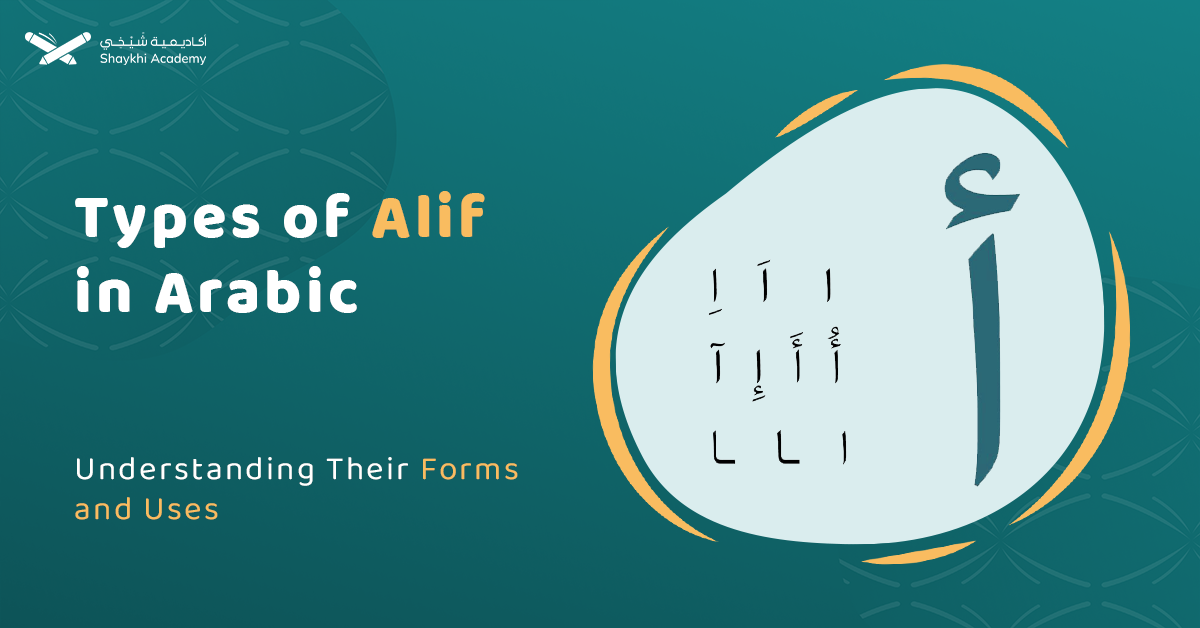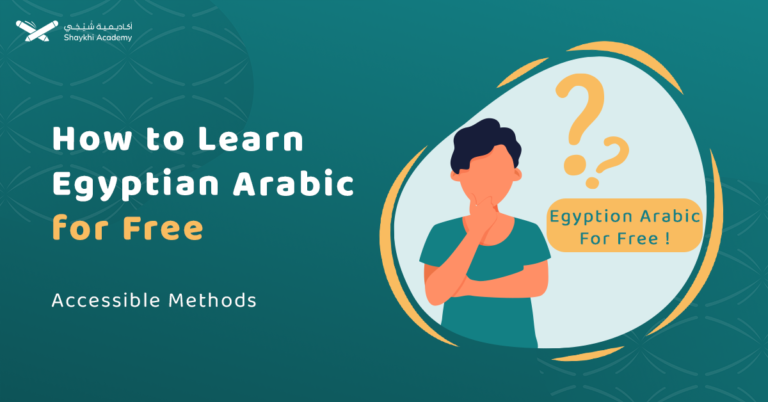In Arabic, Alif has two primary types: Alif Al-Wasl (silent, connecting) and Alif Al-Qata’ (pronounced with Hamza). It also has several forms depending on its position in a word and associated harakat, affecting pronunciation.
The alphabet is essential for learning any new language from scratch. As with any language, the Arabic alphabet is a start in the process of learning the Arabic language, as it’s the cornerstone of the language.
Alif is the first letter in the Arabic alphabet which can be used as a vowel or a consonant. It has multiple types and can be written with or without hamzah. Alif is a unique letter in Arabic that is used in most words with special rules of writing and phonetics.
In this article, we will discuss the letter “Alif” in an interesting way. This article will provide information about its types with examples of each one, its 4 forms, its harakat, and the seven alifs.
Types of Alif in Arabic with Examples:
You might wonder how many types of alif are there in Arabic, there are two main types of Alif in Arabic letters depending on how it’s written and pronounced at the beginning of the word.
1. Alif Al-Wasl:
Alif al-wasl, or (the connecting alif), is a silent alif, or not pronounced alif, at the beginning of the word without hamza “ا”, which looks like it’s connecting words. The alif in “الـ” which means “the” is alif al-wasl.
We also have some specific words that start with alif al-wasl in Arabic, like:
| Example | Meaning | Example | Meaning | Example | Meaning |
| “ابن” (Ebn) | “Son” | “امرئ” (Emri’) | “Man” | “اسم” (Esm) | “Name” |
| “ابنة” (Ebnah) | “Daughter” | “امرأة” (Emra’ah) | “Woman” | “المعلم” (Al-Moa’alem) | “The teacher” |
In addition to previous words, certain verbs start with alif al-wasl, like the imperative form of the triliteral verbs which consist of three root letters. For Example, “اشرب” (Eshrab) means “Drink!”.
All forms of quintuple verbs, which consist of five root letters, except for the present one start with alif al-wasl. For Example, “ابتهج!” (Ebtahej) means “Cheer-up!”.
Also all forms of hexaliteral verbs, which consist of six root letters, except for the present one start with alif al-wasl. For Example, “استخرج!” (Estakhrej) means “Extract!”.
2. Alif Al-Qata’:
Alif al-qata’, or (the cutting alif), is a pronounced alif at the beginning of the word with hamza “أ”, which looks like it’s separating the word’s pronunciation from the one preceding it.
Most words in Arabic start with alif al-qata except for what we mentioned before in alif al-wasl. For Example, “إبرة” (Ebrah) means “Needle”, and “أمير” (Amir) means “Prince” and can be used as a masculine name.
All verbs in present tense start with alif al-qata’. For Example, “أشارك” (Ausharek) means “I am participating”, and “أستخرج” (Astakhrej) means “I am extracting”.
All forms of triliteral verbs, which consist of three root letters, except for the imperative one start with alif al-qata’. For Example, “أكل” (Akal) means “He ate”.
All forms of quadriliteral verbs, which consist of four root letters, start with alif al-qata’. For Example, “أفرج” (Afraga) means “He released”, And “أحضر” (Auhder) means “I bring”.
3. Other Types:
There are other types of alif in Arabic, Like (Alif Al-Ethnain). It’s a specific type of alif that is used in Arabic grammar to create dual forms of words. In this case, it’s conjugated with the letter “ن” (Noon), as “ان”(An).
As a grammatical exception, the letter noon is deleted in the case of the dual form of the verb in both past and imperative forms.
| singular | Meaning | dual | Meaning |
| “معلم” (Moa’lem) | “A teacher” | “معلمان” (Moa’leman) | “Two teachers” |
| “يكتب” (Yaktub) | “He writes” | “يكتبان” (Yaktuban) | “They both write” |
| “كتب” (Kataba) | “He wrote” | “كتبا” (Kataba) | “They both wrote” |
| “اكتب” (Auktub) | “write!” | “اكتبا” (Ektuba) | “Write! Both of you” |
Examples of Words with Alif in Arabic:
Most words in Arabic contain Alif whether with or without hamzah, like:
| Examples | Meaning | |
| Nouns with alif with hamzah above or below | “أرنب” (Arnab) – Above “إنتاج” (Entag) – Below | “Rabbit”“Production” |
| Words with alif as a long “A” or a vowel | “مال” (Maal) “رجال” (Rejaal) | “Money”“Men” |
| Nouns used for duals with alif al-ethnain | “طالبان” (Taleban) | “Two Students” |
| Adjectives with alif | “أسود” (Aswad) | “Black” |
| Verbs for duals with alif al-ethnain | “يكتبان” (Yaktuban) “كتبا” (Katabaa) | “They both are writing”“They both wrote” |
| Verbs with alif with hamzah in the beginning | “أرسل” (Arsal) “أعطى” (A’ata) | “He sent”“He gave” |
What Are The 4 Forms of Alif in Arabic? (Alif in Arabic Writing)
The shape of a letter in Arabic writing is affected by its position and the letter that precedes or follows it. So that leads us to the different forms or types of letter writing in Arabic of the letter “Alif”.
1. In The Initial Position:
In the initial position, alif stands alone and not attached whether with or without hamza like this “أ” or this “ا”. For Example “أسد” (Asad) means “Lion”, and “ابن” (Ebn) means “Son”.
2. In The Middle Position:
In the middle position, alif has two shapes that depend on the letter that precedes it.
It may stand alone like this “أ” or this “ا” if it is preceded by a non-attaching letter. For Example, “امرأة” (Emra’ah) means “Woman”, and “الوادي” (Al-wady) means “The valley”.
Or it may be attached like this “ـا” or this “ـأ” if the letter that precedes it is an attaching letter. For Example, “سماء” (Sama’a) means “Sky”, and “منشأة” (Monsha’ah) means “Facility”.
3. In The Final Position:
In the final position, alif has multiple forms at the end of the words. It may stand alone like this “ا” or this “أ”, be attached like this “ـا” or this “ـأ”, or resemble the letter “ي” (Yaa’) but without dots, like this “ى” or this “ـى” if it’s attached, and in this last case it’s called “ألف مقصورة” (Alif Maqsoora).
| Examples | Pronunciation | Meaning |
| هذا | Hazaa | This |
| مبدأ | Mabda’ | Principle |
| جبال | Jebaal | Mountains |
| مأساة | Ma’saah | Tragedy |
| فرادى | Furaadaa | Individually |
| مستشفى | Mostashfaa | Hospital |
4. When Preceded by The Letter “ل” (Lam):
When preceded by the letter “ل” (Lam), alif takes a new form in writing. They automatically join each other so that the alif looks like it’s resting on the letter “ل” (Lam) to look like this “لا” or this “ـلا” if they are attached.
For Example, “هلال” (Helaal) means “crescent”, and “آلام” (Alaam) means “Pain”.
Let your kids learn more about Arabic in an enjoyable way by joining the Online Arabic Classes For Kids And Toddlers from Shaykhi Academy.
You can also join the Online Fusha Arabic Course to learn more about Arabic with native tutors from Shaykhi Academy.

Book your free trial now!
Alif with The Harakat:
Alif in Arabic has multiple harakat. The pronunciation and shape of alif depend on its harakat which may be: fatha, kasra, damma, or sukun.
1. The Haraka of Fatha:
The haraka of fatha is when the alif has hamza above it and a dash above the hamza like this “أَ” and it’s pronounced as “A” in the word “Angry”. This dash is called “Fatha”.
For example, “أَرنب” means “Rabbit” and is pronounced as “Arnab”.
2. The Haraka of Kasra:
The haraka of kasra is when the alif has hamza below it and a dash below the hamza like this “إِ” and it’s pronounced as “I” in the word “Ill”. This dash is called “Kasra”.
For example, “إنتاج” means “Production” and is pronounced as “Intaj”.
3. The Haraka of Damma:
The haraka of damma is when the alif has hamza above it and a small “و” above the hamza like this “أُ” and it’s pronounced as “O” in the word “Orange”. This small “و” is called “Damma”.
For example, “أمنية” means “A wish” and is pronounced as “Omnya”.
4. The Haraka of Sukun:
The haraka of sukun is different from the previous harakat because it affects the alif in two ways: either it makes it a vowel or a consonant.
A) The Vowel:
Here the alif is written without hamza like this “ا” and when it’s at the beginning of a word it’s called “Alif Wasl”, it doesn’t have its own pronunciation but depends on the previous letter and its haraka.
For example, “فراشة” means “Butterfly” and is pronounced as “Fraashah”.
Another example, “الشمس” means “The sun” and is pronounced as “As-shams”.
There is also alif madd which is the regular alif with madd symbol above it and is pronounced as more elongated “Aa”. For Example, “منشآت” (Monsha’aat) means “Facilities”.
B) The Consonant:
The haraka of sukun is when the alif has hamza above it and a small circle above the hamza like this “أْ”. It can’t be at the beginning of the word because Arabic words never start with a silent letter. This small circle is called “Sukun”.
For example, “رأي” means “Opinion” and is pronounced as “Ra’y”.

Book your free trial now!
What Are The Seven Alifs?
The seven alifs refer to seven words in the Quran Kareem that end with alif, and they have a special rule in Tajweed. That alif will be dropped or read as a short “a” if we recite continuously and will be fully pronounced or read as a long vowel “aa” if we stop at one of these words.
1. أنا” (Ana) or (Anaa) in Different Surahs.
2. “لكنا” (Lakena) or (Lakenaa) in Surat Al-Kahf.
3. “الظنونا” (Az-Zunona) or (Az-Zunonaa) in Surat Al-Ahzab.
4. “الرسولا” (Ar-Rasoola) or (Ar-Rasoolaa) in Surat Al-Ahzab.
5. “السبيلا” (As-Sabila) or (As-Sabilaa) in Surat Al-Ahzab.
6. “قواريرا” (Qwarira) or (Qwariraa) in Surat Al-Insaan.
7. “سلاسلا” (Slasila) or (Slasilaa) in Surat Al-Insaan.
There is only one exception in this rule, The word “سلاسلا”, we can deal with it as one of the seven alifs or we can also drop the alif in both cases stopping or continuing the recitation.
You can learn more about Tajweed and Quran recitation by joining the Best Online Quran Tajweed Classes And Courses from Shaykhi Academy.

Book your free trial now!
Learn Arabic Online With Natives:
Enjoy learning Modern Standard Arabic (MSA) by joining the Online Fusha Arabic Course from Shaykhi Academy. It provides detailed lessons about the Arabic alphabet, simply and easily, with affordable prices and a flexible schedule.
In this course, you will be able to read and write the Arabic alphabet and interact with other Arabic speakers in The Middle East. At the advanced level, you will be able to read Arabic newspapers and understand more complicated written texts.
For more information, you can use the Al-Menhaj book to help you learn the basics of Arabic reading, including Arabic Alphabet letters.
Why Shaykhi Academy?
- Expert Native Tutors: Learn from highly qualified native Arabic speakers.
- Flexible Scheduling: Tailor your classes to fit your busy life.
- Affordable Learning: Access top-quality education at a price that suits you.
- Global Access: Study from anywhere in the world.
Explore Our Arabic Courses:
- Noorani Qaida: Build a strong foundation in Quranic Arabic.
- Comprehensive Arabic Courses: Master the Arabic language, from beginner to advanced levels.
- Fusha Arabic Classes: Delve into Modern Standard Arabic, the key to understanding literature, media, and formal communication across the Arab world.
- Quranic Arabic Course: Enhance your connection with the Quran by learning the language in which it was revealed.
Start Your Arabic Journey Today! Whether you’re just starting or looking to deepen your knowledge, Shaykhi Academy is here to support your journey. Book your free trial now and begin your path to Arabic mastery!

Conclusion:
Alif is the first letter in the Arabic alphabet, and it has unique rules that affect the shape of writing and pronunciation, whether it’s at the beginning, the middle, or the end of words, and whether it carries haraka of fatha, kasra, damma, or sukun.
It can be silent or pronounced as a glottal stop when it carries hamza “ء”, or pronounced as “vowel” when it’s in the middle of the word and without hamza. Alif also has the special rule of seven alifs in tajweed in the Quran recitation.

















































